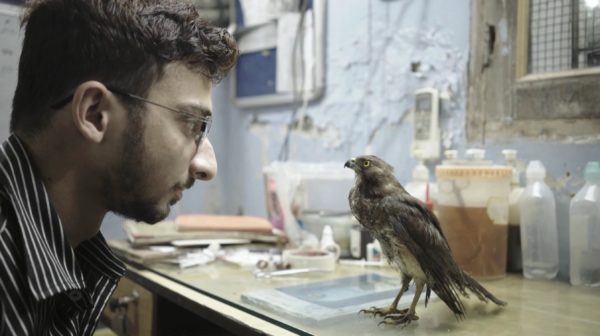At the New York Film Festival: “All That Breathes” — Birds Saved, to Return to a Toxic Sky
By David D’Arcy
It is tempting to call All That Breathes a film of great humanity, but the documentary’s empathy extends far beyond humans.

A scene featuring man and bird in All That Breathes
Delhi seems as far from nature as a place can be. Swarming with people, it has stifling air pollution and a climate that can be even more stifling, depending on the day. When it rains, the streets become rivers of water and sewage.
The political climate can be just as oppressive, depending on who you are. For Muslims, that means being targeted for attack, via an inescapable roll-call of Hindu nationalist broadcasts that screech through the streets. And that venomous air isn’t cordoned off at Delhi’s borders. Those nationalists control the Indian state.
A visually beguiling and tender documentary at the New York Film Festival is quietly building an audience: Shaunak Sen’s All That Breathes. (It opens in New York at Film Forum on October 21.)
In Delhi’s harsh ecosystem, difficult for any species besides Hindu zealots, the film follows a Muslim team of self-taught bird surgeons, led by two brothers and former body builders, Mohammad and Nadeem, and their helper Salik. They’re committed to saving injured birds, especially the black kite, a smallish raptor common to Delhi. The dominant Hindu population scorns the bird as “non-vegetarian” because it eats meat. Under grey sooty skies, these men tend to the birds on their rooftop every day, despite scant resources, technology that breaks down constantly, and the resentment (and far worse) from Hindus.
(A New York Times writer first brought the team to the attention of the outside world in February 2020.)
All That Breathes takes its title from the brothers’ late mother, who told her sons that “one shouldn’t differentiate between all that breathes.” The film, which observes how her sons follow that advice, is dedicated to her.
The air, like the politics in this city, is toxic: humans and all kinds of animals are jammed together in what, to put it mildly, is an overstressed habitat. Some species are able to adapt. Enterprising monkeys use the strands of electrical wires connecting buildings as canopies as aerial canopies through which they travel from place to place.
At night, all sorts of non-human life — from rats to pigs to cows sacred to Hindus – scramble alongside people who sleep on the streets. Tracts of open space become home to jumbles of creatures, urban terrariums. As the “kite brothers” do their work, cringing at radio reports of murdered Muslims, Sen cuts away to meditative close-ups of silent birds, portraits of seemingly stoic observers waiting to be returned to a dangerous sky. Is their silence an expression of trust in their protectors? Or do they know the raw deal presented by the poisoning of their surroundings? Dingy and poetic, All That Breathes is about a shared destiny in an unwelcoming place.
“Life itself is kinship. We all share a community of air,” Mohammad says. For better or worse.
Unwelcoming may understate the toxicity of this environment, yet Sen finds elegance in the kites that, as their guardians put it, are falling from the sky. Not all of them are, however. One of the film’s memorably graceful motifs arrives via a glimpse of the sky where the kites gather in flight. The birds seem to hover, flying and gliding in patterns in what feels like perpetual motion. A hypnotic image of aerial filigree fills the frame.
When the birds return to earth, a stop for many is a vast garbage heap, where the men speculate that some ten thousand hungry kites are responsible for eating enough to shrink the ever-expanding dump’s size. Vultures used to feed here, we learn, but they have disappeared. When legendary scavengers vanish from an environment it may be time to worry.
The luckiest kites, those at the makeshift bird hospital of several improvised floors, are fed a mix of cast-off meat that the men buy from a distributor who once gave them his waste for next to nothing. They grind it into a mulch for the birds. Now, the grocer says, he’s forced to raise his prices. If that weren’t bad enough for the kites, the refrigerator where the men stored their meat fails.
Despondent, one of the brothers plans to leave Delhi to study in the US. Are the bird guardians now going the way of the vultures?
All That Breathes blends the everyday, the elegant, and the iconic as it follows brothers who take on what is beginning to look like a near-impossible avian rescue mission — with the din of anti-Muslim invective growing progressively louder.
Vulnerable and mostly mute, the kites are a reminder that, as the title suggests, everything that breathes eventually shares the same fate, however adaptable the animals that we watch might appear to be. It is tempting to call this doc a film of great humanity, but its empathy extends far beyond humans. And its moments of serene poetry, such as the kites gliding above Delhi, find beauty rising above the most squalid surroundings. All That Breathes is a marvel to watch — Sen is a director whom we’ll be watching.
David D’Arcy lives in New York. For years, he was a programmer for the Haifa International Film Festival in Israel. He writes about art for many publications, including the Art Newspaper. He produced and co-wrote the documentary Portrait of Wally (2012), about the fight over a Nazi-looted painting found at the Museum of Modern Art in Manhattan.
